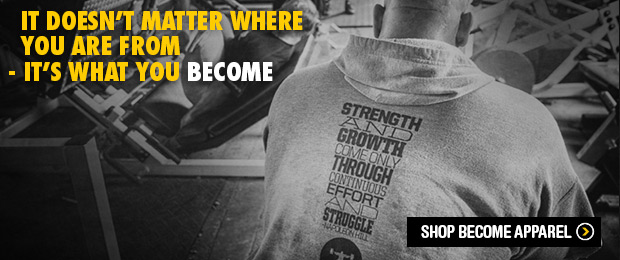
This past year, I read an extremely insightful article on the British National Cycling team and how a change to their training mentality and process brought them international success.
Now before everyone jumps ship from reading, this isn’t an article telling you to do cardio. Rather, the lessons from the British team could be applied to any kind of athlete. I found it especially relevant for powerlifters, strength athletes and bodybuilders, where progress is measured over years.
What Lifters Can Learn from Cyclists
In 2010, the British National Cycling Team, known as Team Sky, got a new general manager and performance director. His name was Dave Brailsford.
Brailsford taught a very unique process-based mentality called “The Aggregation of Marginal Gains.” This philosophy is grounded in the belief that champion level results come from a champion minded process and that process calls for improved performance in every area.
This strategy is a detail driven one but not in the way that you might expect.
When Brailsford was hired to improve the cycling team's performance, he didn’t overhaul their training program and resort to dramatic changes, nor did he obsess over minor details. In fact, he did the complete opposite. He sought one percent improvements in every area possible. Not five percent, 10 percent or 50 percent. Just one percent.

These are marginal gains, but added up over time, they make a substantial difference. And not only do they make a difference. They are easy to implement.
Initially, he started with the bikes. Could the seats be one percent more comfortable? Could the tires be one percent lighter? The suits one percent more aerodynamic? The energy gels one percent better tasting? Could the athletes' diets be one percent better for the energy they had during practice? Steadily, these seemingly minor improvements translated into improved performance, and he didn’t stop there.
When the team traveled, he made them bring their own custom pillows to ensure that they got the most comfortable sleep possible. He tested different massage lotions to see what worked best for his team. He wanted everyone to stay illness free, so he gave them a primer on how to wash their hands.
This mentality is similar to legendary basketball coach John Wooden. Wooden coached the UCLA men's basketball team to ten national titles, and he was known for showing all his rookie players the proper way to wear their socks and tie their shoes.
Brailsford got his entire team involved with this process, encouraging them to find minor details that they felt could contribute to improved performance on the bike. If their cycling shoes felt slightly uncomfortable, he got them better fitting socks. Helmets got sweat in their eyes? New helmets then. The team enthusiastically responded, and it become a collective effort to find these “marginal gains” in every area they could.
When the Minor Becomes Major
Brailsford’s philosophy is, in a way, the inverse of the famous quote by Jim Wendler: “Don’t major in the minor.” Rather, you might call it, “Do the minor for the major.”

Because I work with general population clients as well as highly competitive individuals in lifting endeavors, I've come to define two different mental paradigms. You have individuals who are highly motivated and are “major” driven. They have a process and they're committed to the process, but their personal conviction is what gets them started toward it. They start with the “end” in mind so to speak. The process is something that they tend to take to by default.
In contrast, you have those individuals who may be lacking passion or conviction or just clearly defined directives about what their “major” is. For such a person, starting with very “minor” gains is what will help him steadily build toward creating a “major” shift in his life. These two philosophies aren't competing with one another. Rather, they can complement each other.
When the Details Can Kill You
As a trainer with both general population and competitive clients, I've realized that switching between the marginal gains mentality or the major mentality can have a profound impact on client success. For people who are highly resistant to change, starting with marginal gains that accumulate over time is an excellent way to create the profound changes that are needed. In turn, for competitive individuals, examining the small details within their ongoing process could be the difference maker in their physique or performance.
The major approach is highly alluring and sounds great on paper, but for many people, it just leads to mental resistance when they try to implement it. It's too much too soon. Or as I would often tell prospective clients during our first conversation, “If you're already motivated and committed, you wouldn’t be talking to me in the first place.”
As I said though, this isn’t confined just to fitness and training. “Change” isn't something that most people readily embrace, and simply being a gym freak doesn't mean that you live your entire life with a major mentality. Everyone likely has areas in which they avoid making changes.

Within that broader context, this outlook is one I find highly applicable both on a personal and professional level. How common is it that people are resistant to change, especially major changes? How often do we find automatic reasons for why something won't work before we’ve actually attempted to do anything? This type of mentality is entirely obstacle focused. Confronting it with a large scale shift just leads to resistant.
What are we resisting though? The end goal that is too big for us to take on at the moment? You don’t “start” with the end though. You start with the process of getting there. Hence, if you desire “change,” starting with the single, marginal details can slowly lead to a conversion toward a process-based mindset.
A Really Bad Analogy But a Good Point
An analogy that I like to use is one of putting together a puzzle. If I ask you to put together a puzzle and I dump 2,000 pieces in front of you, do you have to put together all the pieces at once?
No because that’s impossible. That completed puzzle is your “end.” It isn't put together all at once. That’s not how a puzzle works. You put together a puzzle piece by piece. You start with one piece, one marginal detail. Usually it's an edge or border piece. You always start with the border pieces if you know what you're doing. And so then one piece becomes two, two becomes three and so on and so forth.
The more pieces that you link together, the faster the process becomes. However, the beginning is always the slowest, and it always starts with laying down one piece at a time. Consider this the next time that you're mentally kicking and screaming over the prospect of change in your own life. Or consider it when you're a trainer or coach and your client just isn’t doing what you want him or her to do. Are you throwing a major shift at them that is beyond their current scope to handle? Have you accumulated the small gains in habits and behavior that lead toward the big one?
Obstacles are easy to find but reasons are harder. You might find that starting piece by piece is the process to get what you want.











How do you climb El Capitan ? Break it down to what your Head can Handle.